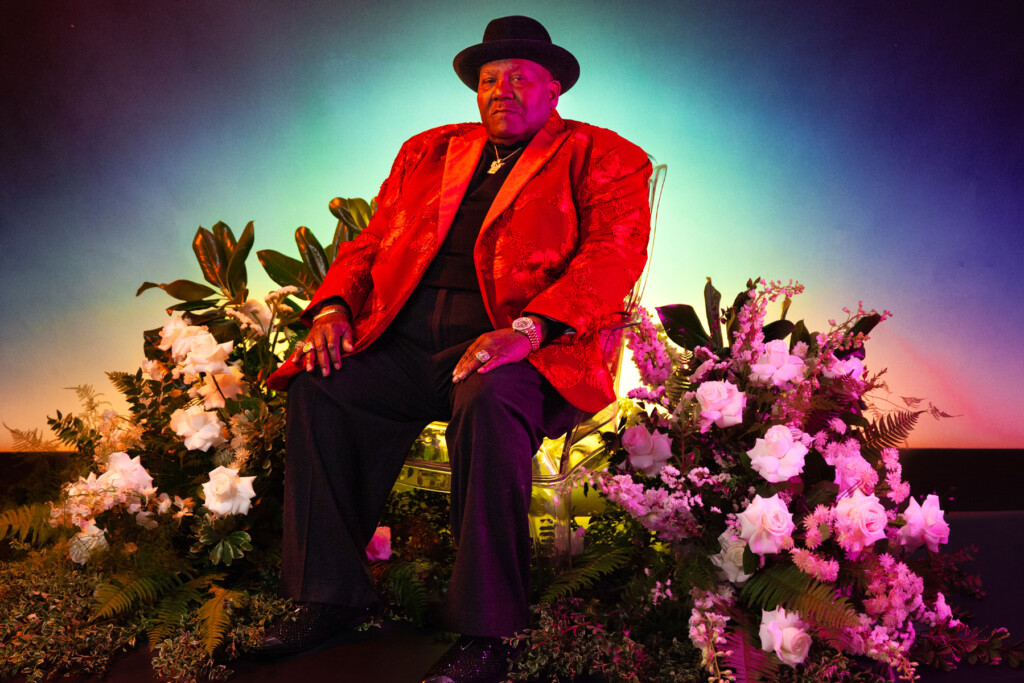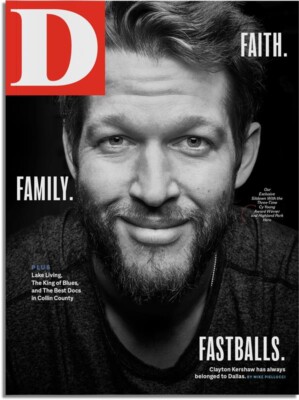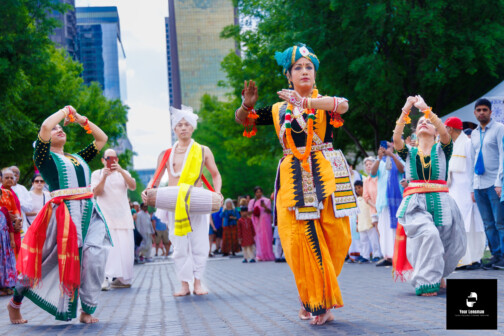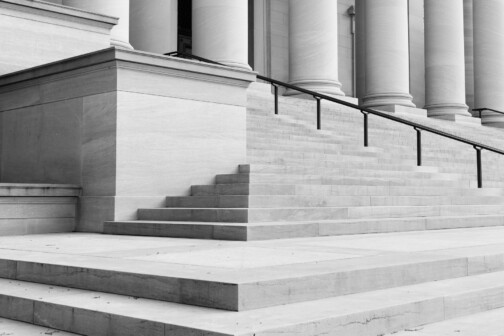On a back road in Kilgore, Texas, a three-legged stool groans under an immense man sitting beside a rusty pickup parked outside his house. The truck’s raised hood yawns at the sameness of every day on this sandy lane across from where once stood C.B. Dansby High School. That was the Black high school. All that remains is a commemorative plaque documenting the segregated school, the place where R.L. Griffin’s football dreams died, and where he learned to drum and sing and so much more.
I’m a backseat rider in R.L.’s 2015 white Cadillac Seville. At the wheel, with R.L. beside him, is his longtime bassist, Hal Harris. We pull up beside the man on the stool. The Right Reverend of the Blues, 83 years old, lets him know: “I’m R.L. Griffin.”
“I know who you are,” the man says, and his gold bottom teeth glisten. “We called you the Blues Singer.”
Indeed they did. They all knew him here, first in the Fifty-Cent House and other small-bore neighborhood dives in East Texas. Later they knew him everywhere.
I heard R.L. for the first time in 1969, on a night when he played the old Red Jacket on Maple Avenue, in Dallas. This was before he became a soul music icon. I was on a double date with my El Centro College fraternity brother John Price. (Wiley came later.) We’d brought our girls to dance to R.L.’s marvelous horn-driven, butt-winding music. When Price busted out a jerky, freeze-framed move, we all quit dancing and made a circle around the maestro to watch him do the robot. He stole the show—something he would keep on doing for decades as a civic lightning rod and Dallas County commissioner.
Fifty-four years later, I told him that story at his club called R.L.’s Blues Palace II, near Fair Park. I was working on an oral history of the Longhorn Ballroom, and he had opened for many national headlining artists who had played there on what were called “Black nights,” when the cavernous country music club wasn’t filled with White people like me. The soft-spoken singer shared compelling stories, and he was generous, calling other blues singers, letting them know he had given me their phone numbers. So I pressed my luck. I asked R.L. if he’d take a road trip with me to the juke joints and clubs that had launched his career in his hometown of Kilgore and in Tyler, Gladewater, and Longview.
“Let’s roll with it,” he said in a heartbeat, suggesting that maybe it was a better idea than I thought.
Harris was the natural choice for wheelman. He and R.L. combined bands in the mid-1980s, when he’d drive the band van to meet R.L. at stops on the Chitlin’ Circuit in East Texas, Oklahoma, and Arkansas. Later on, R.L. bought soul legend Little Milton’s bus, and they traveled together as R.L. Griffin and Hal Harris & The Lo-Lifers. In time, they added the World Famous Hens, a dance troupe of four young women whose comedic butt-shaking brought such acclaim that R.L. features them, or wannabes, to this day at his club, the Blues Palace II. But that’s getting ahead of the story.
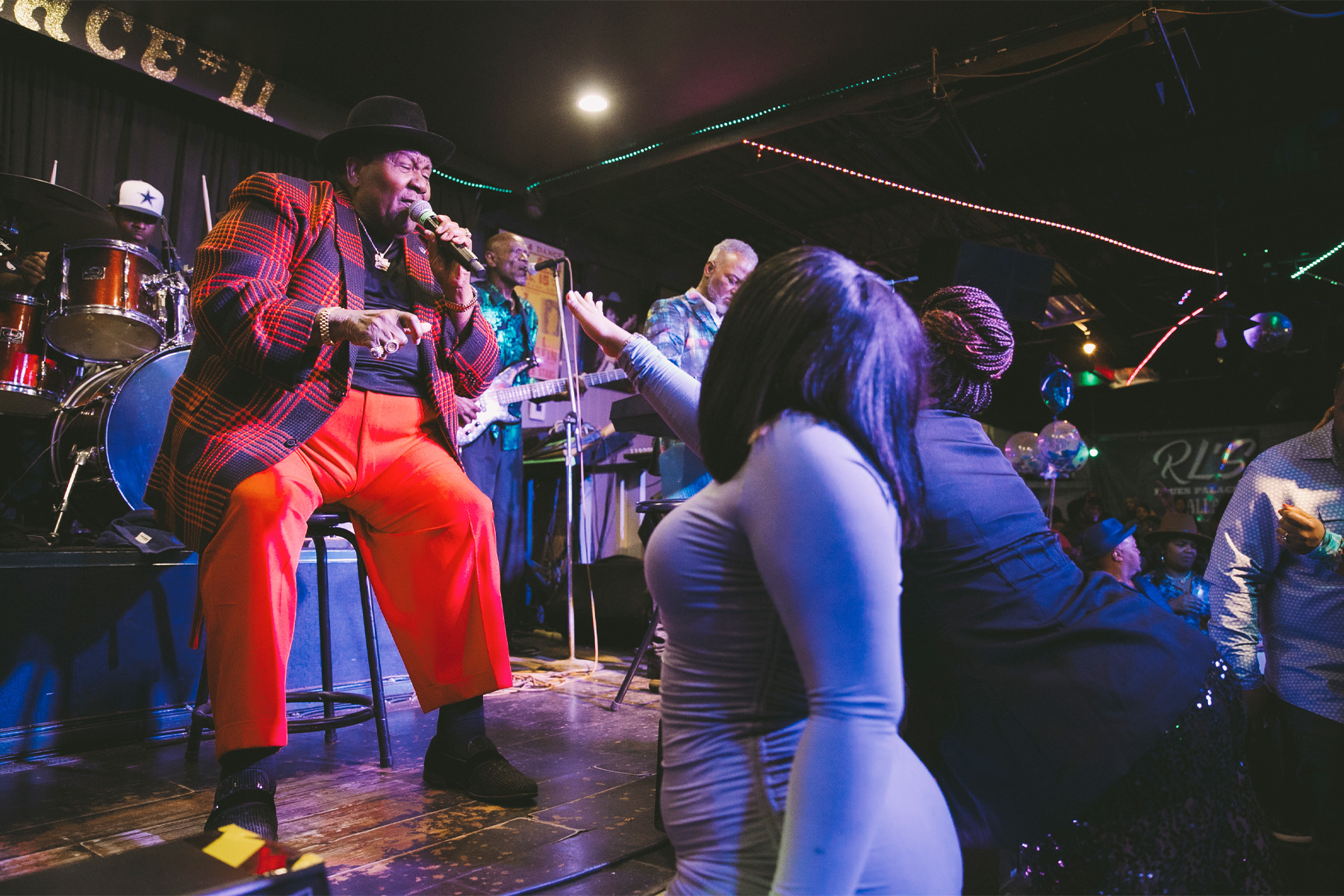
Within shouting distance of Fair Park, R.L.’s Blues Palace II shares spiritual kinship with nearby Deep Ellum, where a hundred years ago these storytelling tunes arose from the sidewalks when Blind Lemon Jefferson and Huddie “Lead Belly” Ledbetter worked the corners around Central Track, singing about poor folks’ struggles. R.L. would gain fame from that music, but as a young man, it was Plan B.
“I was music inclined,” he says, “but I started out playing football.” A first-team fullback, he had large dreams. The school’s band director, Rufus B. Anderson, posed a different idea. “He told me if you don’t go pro in football, you can’t make a living, but you can make a living if you stick with music. … Rufus Anderson really changed my whole life.”
R.L.’s Apollo Theater was the Dansby High auditorium, where he surprised even himself at a talent show. “They had different people sing, and I had never tried to sing before, but the band director called me up. I’d been pecking on buckets in the backyard, and I could always keep a beat. So I came up and remembered the words to ‘Fever,’ by Little Willie John.” Keeping time with drums and singing, R.L. brought the house down.
“Everybody was so excited about me playing drums, but that was the first time I ever tried to sing. After that day,” he says, “I started to think of myself as a singer.”
He and his high school buddies launched a run with R.L. as bandleader, drummer, and singer. He had a tenor he could bend to sound like anyone in R&B. The Sweet Sounds of Music they were called, until a wise girl clued them that Corvettes would be a better handle. And they drew a following, but R.L.’s name wasn’t magic until they opened for Jackie Wilson at Longview’s Reo Palm Isle, a sprawling country music oasis with a door closed to Black customers.
Rex, a White deejay (last name lost to time) on country station KCRN, played R&B a couple of hours a day on his show. He caught R.L. and his band at the Moulin Rouge in Gladewater. Griffin remembers his big break and the moment it happened. Rex tried to soften the bigots’ timeworn slur as he pitched a splendid opportunity.
“I got you a gig at the Reo Palm Isle opening for Jackie Wilson,” R.L. remembers him saying. “I want you to come in, and, truthfully, what they want to hear—and I don’t mean no damn harm, R.L.—but they want B-flat n—-r blues.”
“I know who you are,” the man says, and his gold bottom teeth glisten. “We called you the Blues Singer.”
Griffin enjoys telling that story, laughing at the cringe word he weathered and likely worse. He says: “And we went in and gave them what they wanted.”
The performance shook up Kilgore. All of East Texas, it seemed, was cheering their native son. That Reo Palm Isle audience included the young founder of Robin Hood Studios, Robin Hood Brians, who would press The Corvettes’ first record, a Griffin-penned single titled “Goodbye, Baby.”
The Corvettes recording session will forever delight Brians for many reasons. His father was looking through the studio window at the horn players and saw them sharing a funny smoke. “Bless their hearts,” he told his son. “They don’t have enough money to buy their own cigarettes for themselves.”
The Corvettes were quite the musicians. “Of all the bands I’ve recorded [over 60 years], they’re the best,” Brians says. That’s a claim for the books, as Robin Hood Studios also recorded Don Henley with his early band Four Speeds, and The Moving Sidewalks, one half of which went on to form ZZ Top.
After Reo Palm Isle, R.L. and his eight-piece band stormed East Texas. It was Friday and Saturday nights at Gladewater’s Moulin Rouge; Sunday matinee at Longview’s Dreamland Inn; Monday night at the Hitchin’ Post in Kilgore or Tyler’s Climax Club, which years later would be R.L.’s home club while commuting from Dallas. El Greco in Kilgore was an occasional destination. Wherever he was, the people wanted to be there.
So hardcore was the following that when some venues booked James Brown, they would pay R.L. to take the night off and not compete at another joint. Instead, The Corvettes got the night off and were guests to watch the emergent Godfather of Soul. R.L. snagged his first important Dallas gig because he could emulate Brown.
“This takes me back,” R.L. says. “I haven’t been down this road since I can’t remember.”
In the Caddy, SiriusXM radio is tuned to the Soul Town station (“Every minute, a classic soul sound”) as we pull into downtown Kilgore. More than 20 oil derricks still scrape the sky, but the merchant area has changed since R.L. lived here. The jailhouse has turned into a salon, and on Main Street, the barbershop where R.L. shined shoes as a kid is now Main Street Vintage Vinyl. I run in to check, and, no, it’s not cool enough to have any R.L. Griffin records.

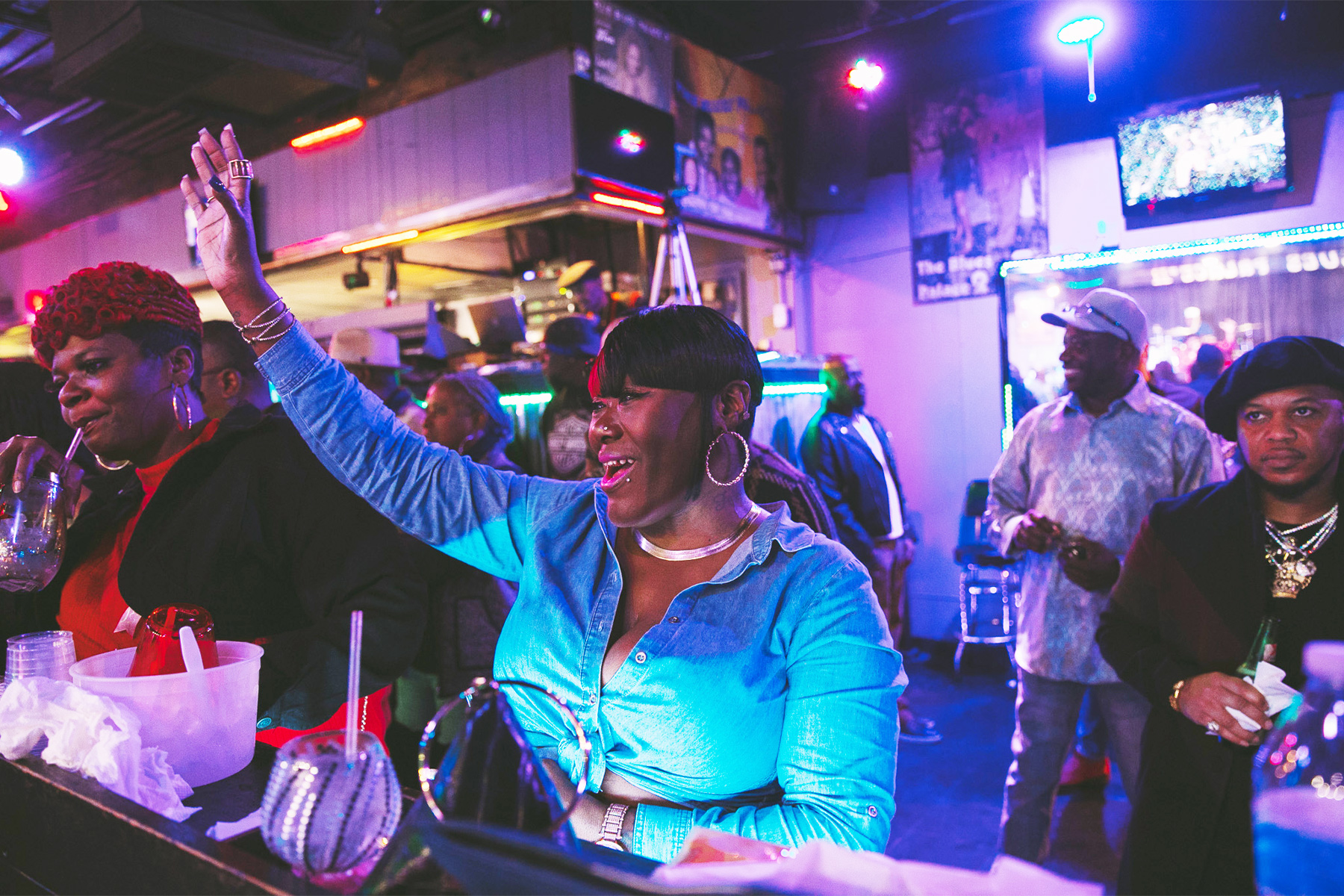
Harris backs out from our parking space, swinging into two lanes. “Watch out,” R.L. says, “you’ll get your ass a ticket.” Remembering the jailhouse, I have to ask if he has ever been inside it. “No, sir,” he says.
We head for the old neighborhood where the Griffin family—grandparents and cousins included—all lived. Sometimes it’s harder to go home than you think. “Hoo-wee, I hadn’t been here in 40 years,” R.L. says. “It looks familiar, but it ain’t the same. I used to come here and eat and drink with my eyes closed.”
We’re feeling our way to 900 Wells Street but can’t find his old house. His mother ran a barbecue stand in the side yard. There’s his neighbor’s place across the street. His son played in The Corvettes. Where we are, though, doesn’t look right to R.L.
He calls his sister who still lives in the house, but she’s at work. He leaves a message, disbelief in his voice: “I’m down here in Kilgore and lost from the house, Wanda.”
Finally he figures it out. This neat, brick-clad house framed by multicolored masonry columns looks nothing like the plankboard house he grew up in. But this is it.
“She fixed it all up,” he says.
Next stop: Longview’s historic Reo Palm Isle (now called the Reo Starplex), the place that played host to his coming-out party. Once on the outskirts of town, it now stands within the expanding city limits, making the gigantic building oddly difficult to locate. John, the owner, converted the 3,000-square-foot dance floor for roller-skating. I introduce him to R.L. and Harris, and we take an inspection tour, talking about the days when R.L. owned the place in a way John never will.
John’s not suitably impressed for my taste. He’d rather revel at saving the historic club from the bulldozers or from becoming climate-controlled storage. R.L. brought along a copy of Living Blues Magazine that features a story about him. I give it to John, but it doesn’t seem to move the needle.
And so we head down the road. Driving in Tyler, the two band buddies shoot the bull about some lost-name club they worked in the 1980s. R.L. points to where the hotel was that Johnnie Taylor stayed in when he played the Harvey Hall Convention Center.
Then R.L.’s remembrance turns to the El Greco Club’s owner, a Mr. Gee, which reminds me of a plan I hatched before we left Dallas. Decades ago, the owner of the Stoneleigh P, Tom Garrison, drew a map for me on a brown paper sack. It led to a hidden barbecue spot called Pat Gee’s that sits back in the pines, on a gravel road. I’d eaten there many times, but it had been a while. I figured if I could guide us there, R.L. would be impressed.
Hoping for the greatest synchronicity, I ask R.L. if El Greco’s Gee might be kin to my barbecue Gee? “Well, El Greco’s Gee is Black,” he says. “Isn’t your barbecue Gee a White guy?”
He is not. I’d never go yammering about a honey hole of a barbecue joint owned by a White guy, for heaven’s sake.
I’ve located the phone number and call again for the umpteenth time, because R.L. and Harris must taste this barbecue for the ages. When a young Gee offspring answers, I’m delighted. “We’re in Tyler,” I tell him. “Can you give me directions to the best barbecue in Texas?”
“Yes, sir, I will,” he says, “but we’re closed and don’t open till the weekend.”
I am crestfallen and not hiding it. “I can’t believe I’ve been jaw-jacking about Pat Gee’s barbecue forever, and I got the days wrong when he’s open.”
“Hoo-wee, I hadn’t been here in 40 years,” R.L. says. “It looks familiar, but it ain’t the same.”
The bluesmen in the Caddy chuckle, because, well, they know about the blues.
It was a roundabout road with some struggles that brought R.L.’s band and business success to Dallas. For a time, he caddied and flipped burgers between gigs. “When James Brown came out so hot, I got a job with the Big Bo Thomas show because I could sing the James Brown stuff and kind of dance like him,” he says. “Big Bo and The Arrows was the hottest band in town. Big Bo played at the Empire Room and another club called the Zanzibar. I kind of started getting popular in Dallas.”
Eight years with Big Bo put Griffin alongside headliners Ike and Tina Turner and Sam and Dave. Soon he hit the White clubs such as Phantasmagoria and the Red Jacket with his new name, the R.L. Griffin Show Band. For a while he worked with Showco Productions, which managed Freddie King and Little Gary Ferguson, and he booked Louann’s on Greenville at Lovers Lane, plus the college crowd in and around North Texas.
“He started this club, the Blues Alley [in 1987], that was top of the line, and I believe it saved him,” says Bobby Rush, a two-time Grammy winner and R.L.’s friend since the 1960s. “It got him out of the rat race. He’d bring in me and Tyrone Davis, same thing with Johnnie Taylor [Blues Hall of Famer and Dallas resident], same thing with Little Milton. Whoever he brought to his club, he would be the opening act. That was a smart move.”
His popularity surging, R.L. often appeared as an opener on those Black nights at the Longhorn, which national acts called the Carnegie Hall of the Chitlin’ Circuit. When Griffin first played the Longhorn, he opened for Bobby Bland (whom Mick Jagger once came to see there). He opened for Little Milton and Dallas native ZZ Hill (who Griffin says smashed the attendance record) and many others. National acts sought him out because, even though he hadn’t had a hit record, he had that following.
“The big artists want someone who can draw some people to them. I was known for being able to do anybody’s stuff,” he says. “I’ve been blessed to sing any of their songs and can sound like them. That’s what gave me a little clout.”
That clout rippled out to others over time, says KNON format director Don O. “I know Andrew ‘Jr. Boy’ Jones got his first solo record deal when I took a label owner to the original Blues Palace,” Don O says. “He was playing in R.L.’s band back then. Tutu Jones, Smokin’ Joe Kubek, Big Charles Young, Harold Walker, and many others got early breaks with R.L. He has always been a very giving and supportive bandleader.”

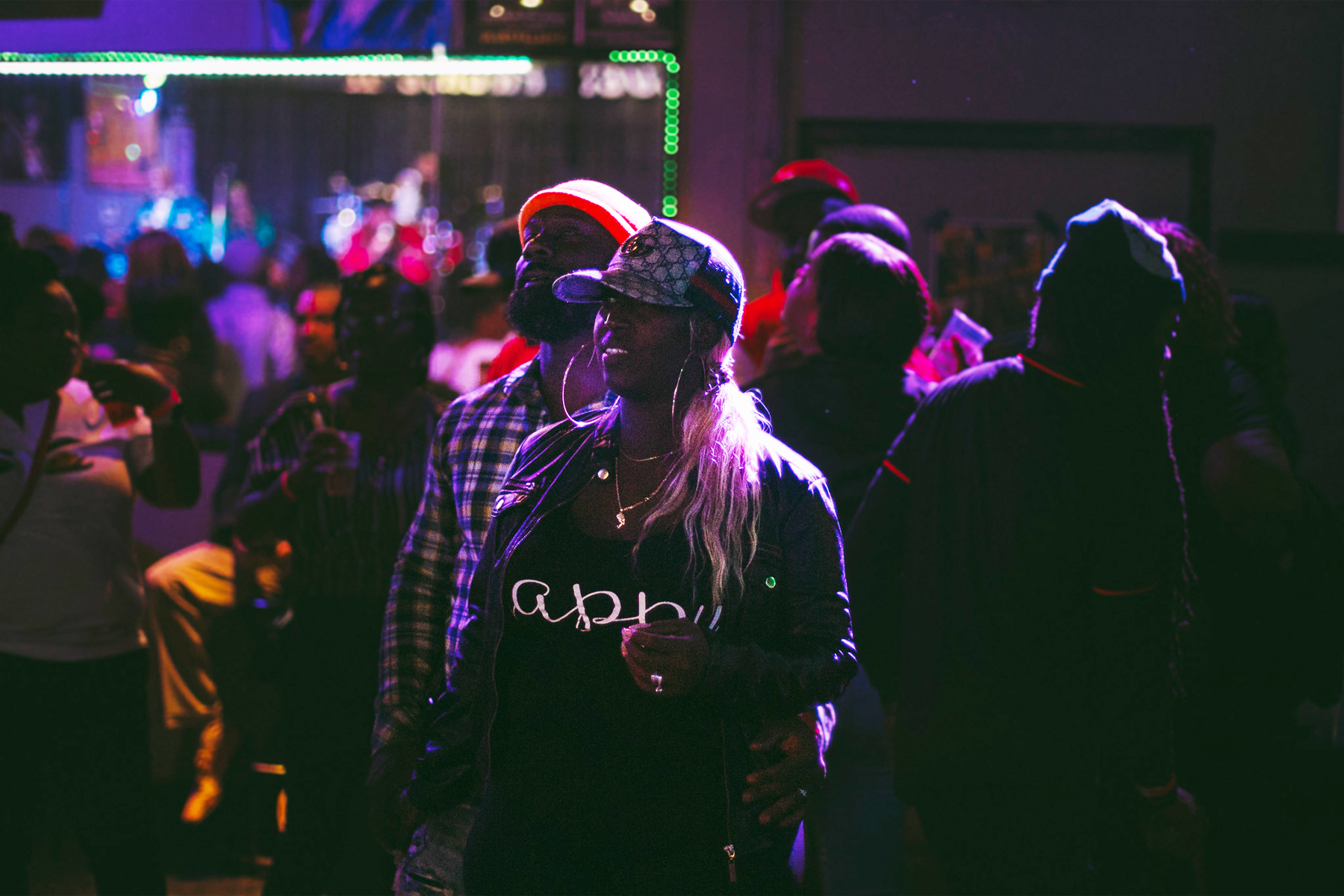
R.L. collected his nickname—the Right Reverend of the Blues—from a fellow broadcaster at KKDA, Sweet Willie Mitchell. “You know when a preacher is preaching and he wants to get a point over to you, he’ll add something to his message. He ad-libs,” R.L. says. “So I add something to a song. People like that.”
R.L. knows what people like. His popular Blues Palace II, the successor to his original Blues Alley across the street, is open only on Friday and Saturday nights, because Sundays he’s a deacon at his church. He says he puts nothing before God.
The club enforces a minimum age of 25. “By the time you’re 25 to 30, you got some sense about being around grown folks,” he says. “I’m not into the young people set, just the older people who want to come out and have some fun for three or four hours and then go home. That’s what I’m into.”
A casual, make-your-own-party vibe fills the place because that’s R.L. People bring sacks of Henderson’s fried chicken, which is just a couple of doors down. There’s BYOB Champagne and whiskey, or you can buy beer and wine from the half-dozen waitresses. And tonight, blue helium balloons bob above the chairs for several birthday parties.
The lighting is dim but not nightclub low, so you can see what’s going on. It’s a throwback to another era. A wall banner features the KKDA-AM call letters, for when the station was the pulse of the Black music community. The pictures and posters on the walls are R.L.’s buddies, all blues and soul heroes—Bobby Rush, James Brown, Little Milton, Al “TNT” Bragg, Lattimore Brown, ZZ Hill—and all gone except for Rush, the last man standing among the legends.
My first midnight set at the Blues Palace II, I can hear R.L.’s fine tenor, but I don’t see him onstage. Then here he comes from the wings, a jaunty showman with a big Buddha belly accented in powder blue pants and shirt, and a sea captain’s hat with gold filigree on the bill, tossing a wireless mic between giant-ringed hands when he sings. It seems so effortless, as if this packed house of 300-plus is for his entertainment. He’s having fun, laughing in his unmistakable falsetto, with us and maybe at us, but we don’t care.
R.L. has whatever it is that the most fun guy in the room has. And at 83, he can still hold a double-lung-full note on Johnnie Taylor’s “Running Out of Lies” (while the crowd repeats the refrain in unison: “It’s getting hard to think of an alibi”). R.L. has one hell of a voice.
“Yeah, I held that note, didn’t I?” he tells me later with a grin. “You got to have your voice right when you do that, though. That ain’t easy to do. I just take my breath, take my time, just hold it. My vocal cords are in good shape. I don’t smoke and drink, none of that. Never have.”
As the night unfolds, R.L. still has something else the regulars never tire of. “Time for the World Famous Hens!” he announces, and everybody stops dancing in anticipation. He does this bit where he’s the rooster and calls for the hens to come up and strut, a shenanigan gifted from the showboating Bobby Rush. Several women go onstage one at a time and bend over, hands on the drum riser, booties to the audience, and shake what their mamas gave them.
R.L. tilts his head like a curious dog and inspects one of the gyrating butts. “I think it’s talking,” he says.
He looks puzzled. Against all reason, he’s certain this fanny has something the crowd needs to hear.
“Let me see here,” the captain says, putting his microphone a little closer. “It is saying something.”
The band is playing low, and we’re all caught in the moment, wondering what happens next. For a nanosecond, R.L. almost convinces us that he’s not pulling our leg. He cocks his head again, working the gag until the wide-eyed “Eureka!” moment, then declares: “It is talking. But it’s Spanish!”
The crowd loves it. They’ve been loving the Blues Palace brand in one name or another for three and a half decades.
“Yeah, I held that note, didn’t I?” he tells me later with a grin.
Gregg A. Smith hosts Blues Revue on Friday mornings on KNON. A former KKDA deejay with R.L., he has seen clubs and music styles pulse and perish, and he calls his friend a “landmark legend” in musicianship, savvy, and stature. R.L. surrounds himself with quality like Big Jack Williams on trumpet and sax man Lee Charles from Johnnie Taylor’s band. “R.L.’s always had a great, great band,” Smith says.
And why does his Blues Palace II still thrive while other clubs are but a faded matchbook with a forgotten name? It’s simple, Smith says: “Griffin has succeeded for an unheard number of years in club life because he has always put his patrons first, making sure they were looked out for, that he had no incidents at his club.” In a rough neighborhood, R.L. keeps attendants in the parking lot for the late evening shows.
He takes care of business outside the club, too, in the community. Smith and his wife, Barbara, partnered with R.L. for their 20th Christmas toy drive at the club in memory of Barbara’s son, Larry Tutson Jr., whose giving spirit was ended by gun violence in East Dallas.
Heading west back toward Dallas, Harris at the wheel remembers a fine hamburger joint, and we vector for Dairy Palace in Canton, home of “World Famous Hamburgers.” It’s not Pat Gee’s Barbecue, is all I can think. These tasty burgers, however, bolster the grandiose claim. Between bites in the restaurant, R.L. is back on the phone with another sister from Houston, marveling at how much his old home has changed.
Truth is, everything else has, too. C.B. Dansby High School was razed; all that’s left is that plaque. Gone is the Union Baptist Church, where his mama swatted him so many times for talking that she only needed to give him a look and he would shut up. Moulin Rouge, Dreamland Inn, El Greco, Hitchin’ Post, Climax Club—all gone.
Burger fortified, we head for home as the day grows into the shank of the afternoon. R.L. is tired of talking and announces, “We have to cool it for a while.”
I don’t know if that means no more questions for this afternoon or until 2024. But for now, he’s done. I figure R.L. has been stunned by his vanishing past and is trying to come to terms with it.
Now it’s up to him, Harris, and me to find comfort in the quiet, the music on the radio barely audible. It occurs that the real test of a favorable trip is a truce of silence at the end of a long day shared. Sticking the landing to our East Texas quest satisfies, even if the roller rink Reo Palm Isle was the only club sighting on the tour.
When we pull in to the Blues Palace II, I notice for the first time the Little Milton mothballed bus. It sits parked against a back fence, with faded purple paint but tires still up and seemingly ready to roll. It’s a good spot for a photo of the band buddies in front of the decommissioned Greyhound coach.
I gather my pork rinds and notepads but can’t locate the Living Blues Magazine that I’d written so many questions and notes in. I mutter that I must have given it to John, the unimpressed Reo Palm Isle owner.
R.L. sees his opening to poke a little fun: “He’ll be looking at your notes, and he’ll be calling me wanting to do a story instead of you.”
He seems revived a bit. He’s back to being playful.
“Hey, R.L.,” I say, “we still need to talk a little more. See you soon?”
“Yeah, in about two years.”
The first time I got to talk with R.L. was in October. He told me he was barely hanging on in his club business. The last time was near Christmas, when he turned 83 and had a huge party at the Blues Palace II. He gave me a copy of his new CD, I’m Back.
I’m not sure if he knows which it is for him, if he’s hanging on or if he’s back. But he’s unabashedly grateful for what he has. Also grateful is the throng of friends and fans he has thrilled since he came out of East Texas.
That CD’s final cut is titled “Lord, You Been Good.” I asked the Right Reverend of the Blues if it was just a song title.
“No, sir,” he said. “He’s been good. I mean really, really good.”
This story originally appeared in the April issue of D Magazine with the headline, “The Right Reverend of the Blues.” Write to [email protected].


